 The bird life of the American continents is very different from those found in Africa. The differences between the two American continents themselves are quite marked, if perhaps less varied in the tropical areas. Not only is North America a new continent for me, but neither have I been as far north as Canada before (the short time in Holland when I was six months old doesn’t count). So although to any American or Canadian a chickadee or a Bluejay might be a common thing, to me they are wonderfully new and different. Not even the gulls are the same! My favourite gull is the Ring-billed Gull (Larus delawarensis). For my SA readers: you know those big gulls with the black backs you always see at the beach? Well, Ring-billed Gulls are that size, but with whitish-grey backs instead of pitch black. Around their sun-yellow beaks they have a black ring, as if someone put a small black elastic just at the tip of their beaks.
The bird life of the American continents is very different from those found in Africa. The differences between the two American continents themselves are quite marked, if perhaps less varied in the tropical areas. Not only is North America a new continent for me, but neither have I been as far north as Canada before (the short time in Holland when I was six months old doesn’t count). So although to any American or Canadian a chickadee or a Bluejay might be a common thing, to me they are wonderfully new and different. Not even the gulls are the same! My favourite gull is the Ring-billed Gull (Larus delawarensis). For my SA readers: you know those big gulls with the black backs you always see at the beach? Well, Ring-billed Gulls are that size, but with whitish-grey backs instead of pitch black. Around their sun-yellow beaks they have a black ring, as if someone put a small black elastic just at the tip of their beaks.
–
–
–
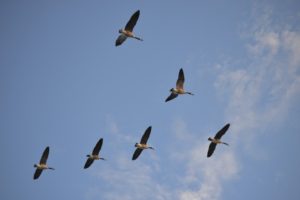 There were plenty of Canadian Geese (Branta canadensis) to be seen here and there on lawns during the day and flying overhead in their big ‘V’ formations in the morning and evenings. They were always in rather big flocks. The Canada goose is a big bird, with brown/grey bodies and long, coal black necks. Someone – who was either whitewashing a house or baking a cake – must at some point have grabbed the goose by the head, with their hand just under its beak and their fingers going to just behind the eyes, because that part of the goose is as white as snow. Clean snow. These birds are also
There were plenty of Canadian Geese (Branta canadensis) to be seen here and there on lawns during the day and flying overhead in their big ‘V’ formations in the morning and evenings. They were always in rather big flocks. The Canada goose is a big bird, with brown/grey bodies and long, coal black necks. Someone – who was either whitewashing a house or baking a cake – must at some point have grabbed the goose by the head, with their hand just under its beak and their fingers going to just behind the eyes, because that part of the goose is as white as snow. Clean snow. These birds are also
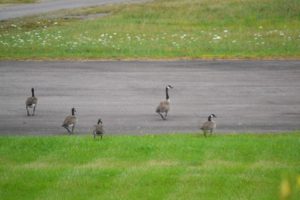 apparently clueless as to where the Canadian border actually lies, for they spend most of their time in the United States : P. They only venture into Canada in the summer. It probably has to do with the fact that Canadians don’t need a passport to cross the border, just an advanced drivers’ license would do and if you can fly without an airplane your license is probably advanced enough : ).
apparently clueless as to where the Canadian border actually lies, for they spend most of their time in the United States : P. They only venture into Canada in the summer. It probably has to do with the fact that Canadians don’t need a passport to cross the border, just an advanced drivers’ license would do and if you can fly without an airplane your license is probably advanced enough : ).
There was a canyon effect in Big Harbour at the wharf house, and when the geese flew by their honks would echo off the cliffs.
I had the most birdwatching opportunity while we were staying at the wharf, for there we were already on land and I didn’t bother anyone by just going for a walk. A birdwatcher’s walk is very different from that of a normal person, it is slower for starters and involves quite a few random stops.
 The road from the wharf house runs at a curved incline at first and then it turns into the straight main road that leads to the big house. I loved that first windy bit, because there was always life there. Lower down the trees grew tall next to the road, and higher up the grass and purple flowers stood tall – in these latter plants the Song Sparrows (Melcspiza melodia) live and play.
The road from the wharf house runs at a curved incline at first and then it turns into the straight main road that leads to the big house. I loved that first windy bit, because there was always life there. Lower down the trees grew tall next to the road, and higher up the grass and purple flowers stood tall – in these latter plants the Song Sparrows (Melcspiza melodia) live and play.
–
–
–
These perpetually cheerful little birds could always be heard. Brown with white breast bedecked with short vertical stripes, in the middle of which nestles a brown dot. They were hard to get photos of because of their distractible nature and love of tall grass.
–
–
–
–
Another bird frequently both seen and heard in Cape Breton is the Bald Eagle (Haliaeetus leucocephalus). All of you who know of the Bald Eagle’s decline and near extinction in the last century (all of which I knew nothing till Florida), will be happy to know that their numbers are starting to recover, especially in Canada. So even though it is America’s national bird, it is more plentiful in another country : p. The problem had been a certain fertilizer used by farmers which got leeched into the rivers and streams and absorbed by the fish. The chemical the eagles absorbed from the fish they ate caused their eggs to have very thin shells, thus giving a very low nesting success rate as the eggs broke or cracked easily. Everywhere in Cape Breton if you keep your eyes open you can often see one sitting in a tree over a body of water, or flying about. There was a pair living at Big Harbor where the wharf house is; in the mornings or on rainy days i often heard them calling to each other and occasionally if I was looking I saw them fly by.
–
And now, about the Puffins. Yep, we got to see Atlantic Puffins (Fratercula artica) : D. There are two islands next to Cape Breton on which the puffins breed, and we went on a tour boat to go gaze at them from afar. Lily came with us, along with one of her Nova Scotian friends.
–
–
–
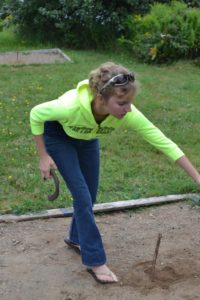 There had still been a mishap because Lily had accidentally taken Lucy’s jacket and not her own. In the end she and I swapped jackets because I fit into Lucy’s jacket better than she did : P. It was a cold, drizzly day, so we both wanted jackets.
There had still been a mishap because Lily had accidentally taken Lucy’s jacket and not her own. In the end she and I swapped jackets because I fit into Lucy’s jacket better than she did : P. It was a cold, drizzly day, so we both wanted jackets.
Now, imagine a puffin, with its colourful red-and-yellow beak, white face and breast, but pitch black wings and back. Now immediately make it a lot smaller, a little shorter than a A4 paper. These birds have to be small for the perfect ‘body weight:wing length’ ratio. Their wings are short and stubby, perfect for propelling them around in the water. If their wings were longer they wouldn’t be able to swim well; if their bodies were larger they wouldn’t be able to fly. As it is the puffins only have one flight speed – they fly with fast, constant flaps, quite fast. If they slow down at all during flight they would actually just fall. So if they fail to completely align themselves with their nesting holes in the cliff face, they have to fly a wide circle to try again and again until they are aligned perfectly so as to just slip into their holes.
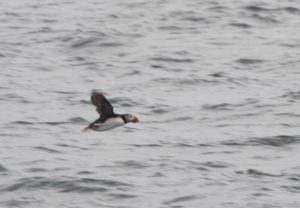 Puffins are pelagic, which means they only ever come to land in order to breed. They’re sort of forced into it, actually. The colourful bits on their beaks start to overgrow just before breeding season and it hampers their ability to hold fish. Thus they have to come to their breeding islands in order to scrape their beaks back into shape against the rock. Over decades these scrapings have carved out lots of nesting tunnels in the cliff fact of the island they breed on. If no rock tunnels are available they borrow their own tunnels into the turf on top of the islands, but these are more accessible for opportunistic gulls.
Puffins are pelagic, which means they only ever come to land in order to breed. They’re sort of forced into it, actually. The colourful bits on their beaks start to overgrow just before breeding season and it hampers their ability to hold fish. Thus they have to come to their breeding islands in order to scrape their beaks back into shape against the rock. Over decades these scrapings have carved out lots of nesting tunnels in the cliff fact of the island they breed on. If no rock tunnels are available they borrow their own tunnels into the turf on top of the islands, but these are more accessible for opportunistic gulls.
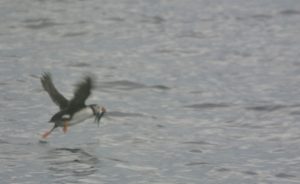 If possible, puffins will stay with the same mate throughout their lives. The pairs do not leave the islands together, so they need to find each other again after reaching the island. If the other mate doesn’t arrive soon enough, a new mate will be chosen.
If possible, puffins will stay with the same mate throughout their lives. The pairs do not leave the islands together, so they need to find each other again after reaching the island. If the other mate doesn’t arrive soon enough, a new mate will be chosen.
–
–
–
–
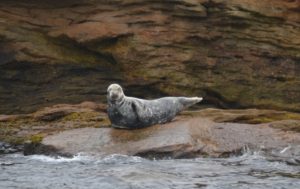 Of course the puffins do not have the island all to themselves. Comorants, kittiwakes (a kind of gull) and Hering gulls nest at the top; razorbills and Black Gullimots (pitch black birds with a broad white stripe on each wing and cherry red legs; also pelagic) share the cliffs. There were other gulls and a few herons on the island as well. Around the island and our tour boat there was also Grey Seals, heads poking out of the water in curiosity, and a few lying lazily on some rocks.
Of course the puffins do not have the island all to themselves. Comorants, kittiwakes (a kind of gull) and Hering gulls nest at the top; razorbills and Black Gullimots (pitch black birds with a broad white stripe on each wing and cherry red legs; also pelagic) share the cliffs. There were other gulls and a few herons on the island as well. Around the island and our tour boat there was also Grey Seals, heads poking out of the water in curiosity, and a few lying lazily on some rocks.
–
There was also a very large presence of Bald Eagles. These move in when the breeding gulls move out, making all the other breeding birds nervous. As soon as the Bald Eagles started coming most of the breeding birds cut the season short and left early, which is why we saw no razorbills or kittiwakes. Luckily only most of the puffins had left before our tour and not all the puffins. We still got to see quite a few groups sitting on the water, and a handful trying to fly into their burrows. A group of puffins would be spotted by someone, and then the tour guide would kind of try to sneak closer with the boat. A few of the puffins flew up if we got too close, but most dug into the water with their wings and disappeared from view.
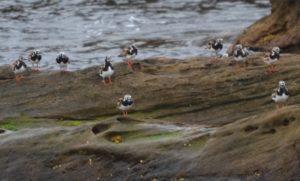 These little birds are Ruddy Turnstones (Arenaria interpres), in their summer feathers.
These little birds are Ruddy Turnstones (Arenaria interpres), in their summer feathers.
Insert from Marike: I do the photos, and I thought this particular one deserved a spot in this post because of the way Franci adored them while we were on the tour 😉
 Even though most of the puffins were gone, the puffin chicks were still safely in their cliff nests, though we couldn’t see them. It is the practice of the parent to feed their chicks so “trommel dik” (Afrikaans saying) that the chicks are not physically able to fit through the entryway to the nest! By the time the chicks have slimmed down enough to fit through the entryway their parents are long gone and the chicks have matured to adulthood, fully able to take care of themselves.
Even though most of the puffins were gone, the puffin chicks were still safely in their cliff nests, though we couldn’t see them. It is the practice of the parent to feed their chicks so “trommel dik” (Afrikaans saying) that the chicks are not physically able to fit through the entryway to the nest! By the time the chicks have slimmed down enough to fit through the entryway their parents are long gone and the chicks have matured to adulthood, fully able to take care of themselves.

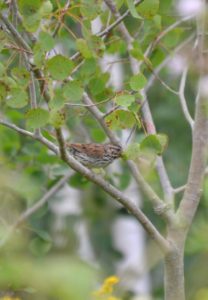
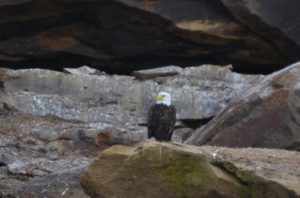
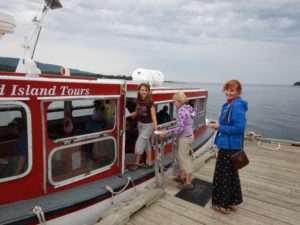
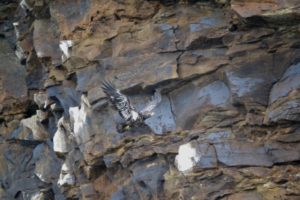
Recent Comments